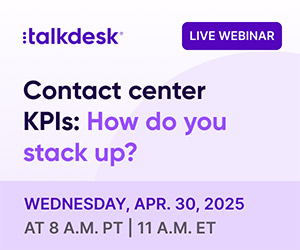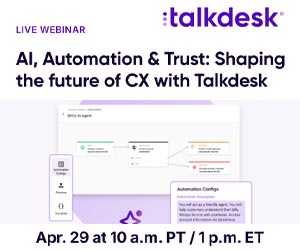Vonage explores how AI-powered contact centre solutions are transforming the way businesses manage customer service, from intelligent call routing to real-time sentiment analysis.
AI is changing what’s possible. It’s changing how we work. Virtual assistants, predictive analytics, and other AI tools empower businesses from all industries. Did you know that AI-powered software saves your agents time and enhances the customer experience (CX)?
With AI in contact centres, your team will better understand your customers and how to meet their needs. Self-service virtual assistants, intelligent call routing, and other AI features support your team and enhance customer interactions. Contact centre AI (CCAI) improves agent productivity while increasing first-contact resolution (FCR).
What is Contact Centre AI?
Contact centre AI uses artificial intelligence to support the end users of contact centre software. AI capabilities help personalize and tailor customer service interactions by analysing conversations.
CCAI uses technologies such as machine learning (ML) to recognize patterns and build predictive models. Natural language processing (NLP) and deep learning enable the AI to recognize speech and generate responses.
Contact centre AI capabilities include:
- Automation of manual and repetitive tasks, reducing post-call work
- Customer self-service through virtual agents that handle lower-tier calls
- Routing calls to the right people and departments
- Predictive call analytics to optimize staffing levels around peak demand hours
Examples of AI in Contact Centres
You’re missing out on several capabilities if you haven’t used AI for contact centres. Let’s examine some common use cases for contact centre AI tools.
Contextual On-Call Assistance
Connecting callers to the right department and agent is the first half of the battle. Luckily, contact centre AI technology also helps drive calls toward contact resolution.
For example, AI can analyse a conversation in real-time and step in with useful suggestions, such as providing a link to a knowledge base article.
Smart enhancements like these make life easier for the agent, whose time is now optimized and productivity is increased.
Intelligent Routing
When customers reach out on a communication channel, they expect to reach someone with answers. They don’t want to waste time — they want to get to the right agent right now.
What does this look like when AI is added to the mix? AI looks into numerous data sources, from active conversations to chat history to data from your CRM.
Intelligent and dynamic routing analyses the customer’s needs and routes them to the right agent every time.
Both your business and customers benefit from efficient call routing.
Virtual Agents and Assistants
Intelligent agents and AI virtual assistants can be the first line of contact. These virtual agents determine whether the customer needs to speak to a tier 1 agent or a knowledge expert. In some cases, they may even escalate to a specialized virtual assistant.
In other cases, an AI virtual assistant may determine they can handle the call without involving a live agent. They can offer answers to simple questions or direct callers to ample self-service options. Either way, it saves your agents time and lets them focus on more complex calls.
Sentiment Analysis
Wouldn’t it be nice if your agents could read customers’ minds? AI can’t do that, but it can analyse communications in real time and help determine sentiment.
Agents can be gently nudged when caller sentiment is less than stellar. AI insights improve your team’s understanding of the situation at hand.
Thanks to speech analytics, managers can track the progress of every conversation. Difficult calls might quickly get worse. Sentiment monitoring enables a supervisor to step in with live coaching.
Quality Assurance and Compliance Checks
Conversation Analyser takes the guesswork out of call monitoring for assurance and compliance. Our AI listens to every call, identifying when agents step out of bounds or fail to comply with requirements.
Sentiment analysis also plays a role in better quality management. Call visualizations highlight poor moments during conversations.
Managers can replay exactly what happened and determine areas for improvement. It’s not all negative, though. Great moments of success are also identified, so you can reward your team and gain insights into best practices.
Speech-to-Text
CCAI uses speech recognition to transcribe every conversation and log every call. Data automatically enters your CRM and helpdesk tools, saving an agent’s time. Contact details, case histories, and custom objects stay up-to-date without needing any involvement from your team.
Detailed Reporting and Analytics
Any contact centre software worth using comes with detailed reporting and analytics. Managers can customize dashboards for live monitoring of agent and contact centre performance, and track KPIs such as average handle time (AHT) and customer satisfaction (CSAT).
Each team member personalizes their analytics dashboard to focus on the metrics most important for their role.
CCAI takes analytics to new heights with speech recognition and sentiment monitoring. The AI enables you to track new data types and gain deeper insights into the customer experience.
3 Key Benefits of an AI Contact Centre
Contact centre AI doesn’t take over the role of customer service and support. However, it does change how you communicate and interact with your customers. CCAI also changes the way you run your contact centres.
1. Improved Customer Satisfaction
SurveyMonkey’s AI in Customer Experience report found that 90% of people prefer service from a human agent over a virtual assistant.
So how does CCAI improve customer satisfaction? Intelligent routing ensures callers get to the right agent promptly. This helps them avoid the frustration of being put on hold or waiting for a call to transfer.
Platforms use AI to analyse conversations and help agents find resolutions. If the AI doesn’t have the answer, it can alert a supervisor to join the call and help find a solution. Resolving more issues on the first contact means more happy customers.
2. Increased Productivity
CCAI raises the productivity of your contact centre team. AI transcribes every call. It updates customer account information in your CRM and other tools, reducing post-call work. A conversation analyser marks the highs and lows of every interaction, making it easier to coach and train agents.
Contact centre AI provides 24/7 self-service for customers with lower-tier questions. AI virtual assistants deflect calls, saving your agents for the more complex calls.
And AI-powered contact centre solutions can reduce AHT by up to 25%. It all boils down to getting more out of your contact centre with less work.
3. Reduced Costs
Using an AI-based contact centre solution like VCC helps improve your bottom line. Handling more calls in less time means lower staffing costs. Predictive analytics forecast contact centre demand, ensuring you have the optimal number of agents on shift.
AI conversation monitoring also tracks every interaction for quality assurance. (That’s not humanly possible.) CCAI flags potential compliance issues and takes a proactive approach to prevent costly fines for violating regulations.
Things to Consider About Contact Centre AI Solutions
When considering whether to integrate contact center AI into your business, you’ll need to weigh the pros and cons. Do your due diligence and thoroughly understand what you’re signing up for — that’s why you’re here, right?
What Data Will You Be Gathering, and How Will You Obtain It?
It’s crucial to identify what types of data you’ll be gathering. Will you be monitoring caller emotion and sentiment? How much sensitive customer information will be recorded? What tools will be connected to that data, and how will information be updated?
You must also ensure that any AI tools you use fully comply with organizational and jurisdictional requirements.
How Will Data Consent Be Handled?
Transparency is a must when using AI to gather and analyse data. Customers must be aware that a conversation is being recorded and AI is involved. Consider how you will handle data consent to maintain transparency and compliance.
Basic call recording disclosure regulations must be met, typically at the start of every interaction. However, laws vary by state and geographic region. Tools streamline this process with automated recording disclosure messages.
Do You Have the Right Data Architecture in Place?
Do you have data warehouses or maintain customer data in a cloud architecture? CCAI helps you gather more data from every interaction. The bigger the data, the bigger the storage needs.
In a contact centre environment, where voice communications are the norm and huge numbers of complex customer accounts are commonplace, it’s worth knowing exactly how the information will be physically kept. Use this insight to guide you to a scalable solution that can handle your data needs.
Do You Have Sufficient Security in Place to Protect Sensitive Data?
Monitoring and recording information with customer consent is one thing. How will you protect that data and maintain consumer trust in your brand? Not all AI contact centre solutions are created equal. You want a contact centre platform that provides end-to-end encryption.
Solutions provide enterprise-grade security measures. These tools enable you to control and protect sensitive customer data better.
How Might AI Bias Affect Your Implementation?
Unfortunately, unconscious human bias can’t be fully eliminated from any organization. That’s why businesses like yours are data-driven.
Numbers don’t lie, right? AI bias is a real thing. Sage Journals reports that technologies such as generative AI are even more biased than humans.
AI bias happens because models and algorithms are trained on data. Who provides that data? Humans. Awareness of the potential problem is the first step toward ensuring your contact centre AI experience is uniformly excellent for everyone.
To mitigate biases, you need a process for monitoring and refining AI models. If a model’s output is constantly discriminating or off the mark, you need the flexibility to tweak and adjust the solution.
Implementing Contact Centre Artificial Intelligence
AI is trendy. Don’t make the mistake of overbuying into the hype. AI can greatly transform and enhance your contact centre, from customer experiences to business processes. However, an AI implementation is only effective as the strategy or plan that backs its usage.
1. Define Your Needs
Any business initiative needs a purpose. What are you hoping to achieve by integrating contact center AI? Do you want to reduce handling times or provide 24/7 self-service for ecommerce customers? If you operate in the healthcare industry, improving data privacy and compliance might be your priority.
Every organization will have its own unique needs. Set goals that are Specific, Measurable, Achievable, Relevant, and Time Bound (SMART). Using contact center analytics and reporting, you can monitor the right set of metrics to help you define success and track progress.
2. Decide Whether to Partner With a Vendor or Build Custom AI Solutions From Scratch
There are plenty of options for adding AI to your contact centre operations. The first decision to make is whether you’ll build a bespoke AI solution or partner with a CCAI provider.
The former option requires a good deal of upfront investment. You’ll need IT expertise, data engineers, and data scientists to help build and train an AI model that does what you want.
Opting for a vendor lets you get up and running with contact centre AI immediately. A solution either works the way you want or doesn’t – you won’t find out until you use it.
3. Audit and Centralise Your Existing Data
Like most technology these days, everything depends on data. Where is your existing data currently stored, and how is it managed?
Do you use enterprise resource planning (ERP) software to centralize data? How will you connect various tools like your CRM or helpdesk software to your AI solution if not?
You’ll get more out of the AI by centralizing your data for monitoring and analysis. Take inventory of your data assets and break down existing silos.
Have your data experts evaluate what’s needed to integrate your data sources and get the most out of CCAI. Ensure you have quality data that is clean and ready for AI analysis.
4. Provide Training
Adding AI to your contact centres is a big change. Provide agent training so your team understands how to get the most out of your new tool. Workshops and seminars are also a great opportunity to calm fears and anxieties surrounding the use of AI.
Update management strategies to reflect the goals of your CCAI implementation. Guide managers in using AI and monitoring the most relevant metrics to measure success.
5. Regularly Assess and Make Changes as Needed
Deploying contact centre AI is relatively painless if you opt for a vendor. There may be more growing pains if you opt for a custom-built solution. Either way, you shouldn’t expect everything to be perfect from the start.
Collect constant feedback from stakeholders and end users. Is customer satisfaction improving? What’s the feedback from processes like AI-led self-service? Are your agents adopting the new features and enhancements from CCAI?
Listen to the data and optimize your contact centre AI to your objectives.
Challenges of AI Implementation in Contact Centres
Adding AI to your contact centre tech stack comes with many benefits. But don’t rush into a CCAI implementation without understanding the common pitfalls derailing success.
Pushback From Team Members
Unlike machine learning models that are forever evolving, humans are typically resistant to change. Once we feel comfortable with something, we’re happy to maintain the status quo. New technology initiatives often receive pushback from team members from all levels.
If employees don’t adopt contact center AI, are you just wasting time and money? You can alleviate adoption inertia by educating your team on the benefits of AI and how it will make their jobs easier and improve performance.
Data Safeguarding
Adding new tools and connecting more data always comes with increased risks. Having data stored in the cloud poses unique threats. In addition, you have a long list of compliance requirements to meet.
The Health Insurance Portability and Accountability Act (HIPAA) means you have extra boxes to check if you deal with sensitive customer health information.
If you process card payments over the phone, every interaction must comply with the Payment Card Industry Data Security Standard (PCI DSS).
Many more regulations exist, such as the EU’s General Data Protection Regulation (GDPR). How can you stay on top of them and avoid compliance violations while using AI to manage customer data?
Using AI Ethically
Using AI does raise ethical questions. Is contact centre AI displacing jobs and taking over for your existing team members? Unmonitored models can suffer from AI bias, which worsens if unchecked.
Customers might feel uneasy interacting with AI agents due to their own personal beliefs. Team members are more likely to be worried about job security. As a company, potential customers and employees may view organizations that use AI with apprehension.
How can you maintain trust and loyalty from customers and your team? The number one remedy for this situation is transparency.
Let everyone know you’re using AI and for what purposes. Ensure people know how you monitor your AI tools and mitigate biases.
Challenges of AI Implementation in Contact Centres
Adding AI to your contact centre tech stack comes with many benefits. But don’t rush into a CCAI implementation without understanding the common pitfalls derailing success.
Pushback From Team Members
Unlike machine learning models that are forever evolving, humans are typically resistant to change. Once we feel comfortable with something, we’re happy to maintain the status quo. New technology initiatives often receive pushback from team members from all levels.
If employees don’t adopt contact center AI, are you just wasting time and money? You can alleviate adoption inertia by educating your team on the benefits of AI and how it will make their jobs easier and improve performance.
Data safeguarding
Adding new tools and connecting more data always comes with increased risks. Having data stored in the cloud poses unique threats. In addition, you have a long list of compliance requirements to meet.
The Health Insurance Portability and Accountability Act (HIPAA) means you have extra boxes to check if you deal with sensitive customer health information. If you process card payments over the phone, every interaction must comply with the Payment Card Industry Data Security Standard (PCI DSS).
Many more regulations exist, such as the EU’s General Data Protection Regulation (GDPR). How can you stay on top of them and avoid compliance violations while using AI to manage customer data?
Using AI Ethically
Using AI does raise ethical questions. Is contact centre AI displacing jobs and taking over for your existing team members? Unmonitored models can suffer from AI bias, which worsens if unchecked.
Customers might feel uneasy interacting with AI agents due to their own personal beliefs. Team members are more likely to be worried about job security. As a company, potential customers and employees may view organisations that use AI with apprehension.
How can you maintain trust and loyalty from customers and your team? The number one remedy for this situation is transparency.
Let everyone know you’re using AI and for what purposes. Ensure people know how you monitor your AI tools and mitigate biases.
This blog post has been re-published by kind permission of Vonage – View the Original Article
For more information about Vonage - visit the Vonage Website
Call Centre Helper is not responsible for the content of these guest blog posts. The opinions expressed in this article are those of the author, and do not necessarily reflect those of Call Centre Helper.
Author: Vonage
Reviewed by: Rachael Trickey
Published On: 28th Apr 2025
Read more about - Guest Blogs, Vonage






 Vonage is redefining business communications, helping enterprises use fully-integrated unified communications, contact centre and programmable communications solutions via APIs.
Vonage is redefining business communications, helping enterprises use fully-integrated unified communications, contact centre and programmable communications solutions via APIs. 






























